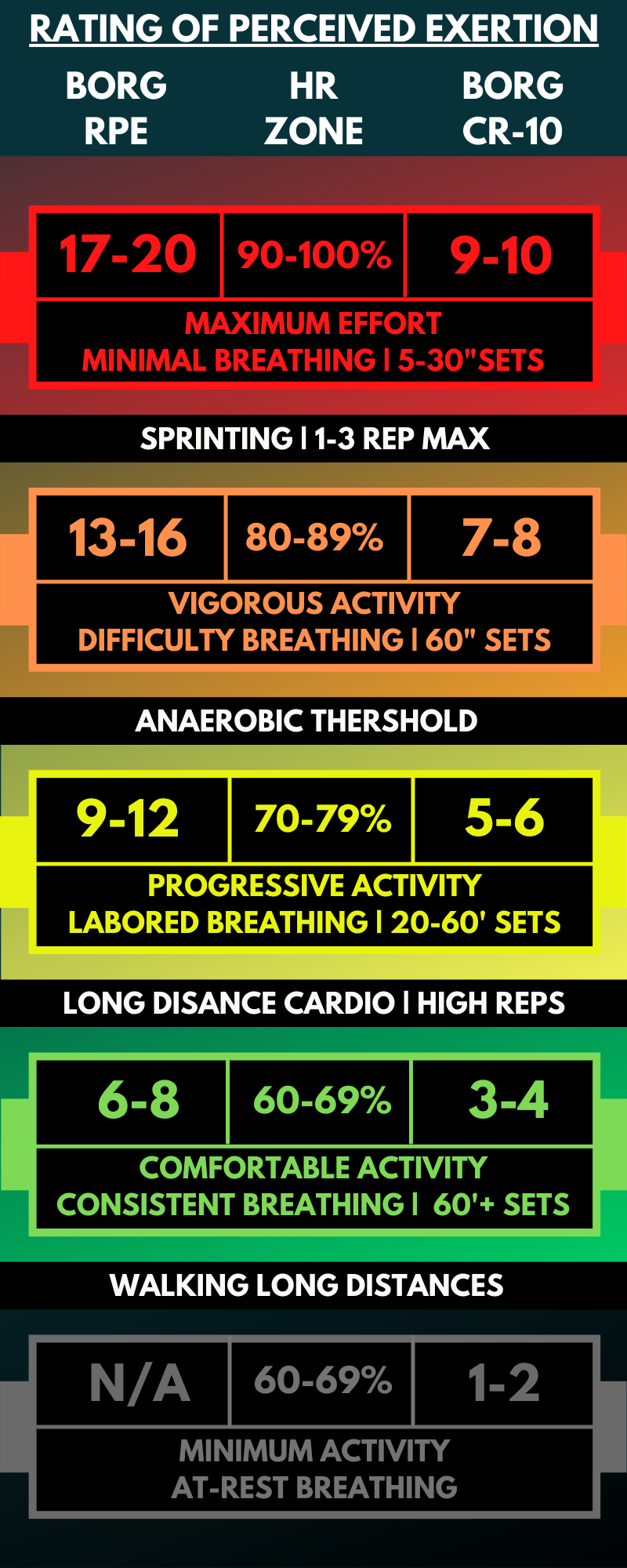How to Create & Use "Rating of Perceived Exertion (RPE)" Scales to Measure Exercise Progress
- Michael Gorney
- May 5, 2021
- 4 min read
Updated: Jul 13, 2021
WHAT IS "RATING OF PERCEIVED EXERTION (RPE)?"
Do you have that ONE exercise or stretch you HATE more than the rest because it is so difficult or intense? On a scale of 0-10 (or 6-20) how much effort did put into that exercise? Rating of Perceived Exertion, or RPE, can be an objective way of measuring otherwise subjective questions such as how much effort someone exerts on a particular exercise or overall workout or how much intensity are they experiencing with a particular mobility movement or stretch. In the health & fitness industry two RPE methods stand out above the rest.

#1 | The Borg Rating of Perceived Exertion Scale
6-20 Rater Scale
Objective Measurement
Based On Heart Rate
More Accurate Yet Time Consuming
#2 | The Borg CR-10 Scale
1-10 Rater Scale
Subjective Measurement
Based On Client Feelings
Simple | Less Time Consuming
Note: When using the traditional Borg RPE Scale add a zero to the RPE number given. For example, if an exercise is given a 9 out of 20 then the heart rate should correspond to 90 beats per minute. This is a general guideline and should be followed loosely but is still a great method of improving the minds connection with the body to understand what different levels of exertion should feel like.
The chart on the right shows the two scales in relation to % Max HR along with methods to subjectively describe each level of exertion. Each person will require different methods to reach each RPE level, however, everyone should experience similar physiological effects when reaching each RPE level.
"RPE CAN BE DIFFICULT TO MEASURE
When someone is asked to rate how difficult an exercise or stretch is they are using subjective information to answer the question. The problem with subjective info is that it is only relevant to that particular person.
For example, John & Jane perform the same exercise - a push-up for 10 reps. Jane has a long history of working out and has been consistently going to the gym and exercising with proper form for years. John sits in his basement playing video games surrounded by empty pizza boxes. Jane would more than likely rate the push-up lower on the RPE Scale than John due to her history of exercise and understanding how the body should feel when exercising. John, on the other hand, would experience a much more stressful and horrifying experience.
An RPE Scale must include descriptors at each level that will provide consistent answers. In the table above, the level of activity, target heart rate zone, type of breathing, exercise duration, and types of exercises are all labeled. This will help provide a "best match" to what level of exertion was felt.
Google "RPE Scales" and you will find hundreds of varieties. Each one will have different combinations of descriptors to help best answer the question of, "how hard was that exercise?" At the same time, there is not a best or worst scale to use. The best advice I can give from personal experience is to create your own scale using your own descriptors. You will have a lot more success with accurately recording RPE. Let's take a closer look on how to do just that.
HOW TO RECORD "RPE" WITH EXERCISE
Let's create our own RPE Scale! Using the CR-10 Scale as a model, each exertion level can be individually labeled or combined together for simplicity. The example above combined the 1-10 scale into 5 sections for simplicity. Each level is designated with a different color. Once the levels are determined we can start adding descriptors to each level to help determine the best choice. Below are some examples.

Breathing Intensity
How hard do you feel like you're breathing?
Respiration Rate
How many breaths per minute?
Heart Rate Zone
How many beats per minute?
Exercise Duration
How long did the exercise last?
If someone was performing a max effort 100 yard sprint and hitting 95% max heart rate then they would say their exertion level would be somewhere between 17-20 or 9-10 depending on what scale is used. This is in contrast to a scale that is only labeled with numbers. Again, to create consistency and meaning to an RPE scale it MUST have unique descriptors applied to provide significant data recordings.
HOW TO RECORD "RPE" WITH MOBILITY
Exertion can also be used to measure progress with mobility & stretching exercises as well. However, we are not measuring "exertion" as much as we are measuring "intensity." By this I mean how did the movement feel on your muscles and joints? Mobility and stretching exercises are slow, calm movements that would never record very high on a typical RPE Scale. Therefore, we have to change around some terms and descriptors to make it applicable to these types of exercises.
WARNING! HIGHER "RPE" CAN INCREASE INJURY RISK
Finally, a quick reminder that with higher levels of exertion comes a significant increase in risk of injury if not maintaining proper cueing, form, and body awareness. When a client marks high RPE scores on particular exercises and workouts make sure to observe and correct more aggressively as to avoid the potential for injury.
BRAIN MEETS BRAWN BLOG POST RECOMMENDATIONS
Check out our latest post "Walking is Exercise | Warm-Up & Cool-Down to Prevent Pain & Injury" HERE.
Looking to improve core strength? Then come learn the scientific secrets to developing strong abs HERE!
Website: www.bmbfitnesssolutions.com
Instagram: @bmbfitnessolutions
Facebook: @bmbfitnesssolutions
_edited.jpg)




Comments